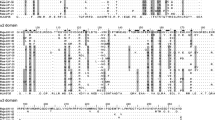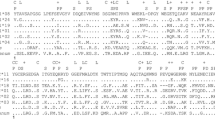Abstract
The genes of the major histocompatibility complex (MHC) are attractive candidates for investigating the link between adaptive variation and individual fitness. We improved rapid amplification of cDNA ends to obtain the whole coding sequence of the MHC class Ia gene of the black-spotted frog (Pelophylax nigromaculata), the most common amphibian in China. We also used genome walking to characterize the partial introns adjacent to exon 3 of the MHC Ia gene. Based on the sequences obtained, we designed locus-specific primers to investigate the molecular polymorphisms of this species in southeast China. The MHC class Ia gene showed a high level of genetic diversity, indicating that this species retains a relatively high potential for survival, despite a population decline among frog species in general and many other amphibians.


Similar content being viewed by others
References
Acevedo-Whitehouse K, Cunningham AA (2006) Is MHC enough for understanding wildlife immunogenetics? Trends Ecol Evol 21:433–438
Babik W (2010) Methods for MHC genotyping in non-model vertebrates. Mol Ecol Resour 10:237–251
Barribeau SM, Villinger J, Waldman B (2008) Major histocompatibility complex based resistance to a common bacterial pathogen of amphibians. PLoS One 3:e2692
Beebee TJC, Griffiths RA (2005) The amphibian decline crisis: a watershed for conservation biology? Biol Conserv 125:271–285
Bernatchez L, Landry C (2003) MHC studies in nonmodel vertebrates: what have we learned about natural selection in 15 years? J Evol Biol 16:363–377
Bjorkman PJ, Saper MA, Samraoui B, Bennett WS, Strominger JL, Wiley DC (1987) The foreign antigen bing site and T cell recognition regions of class I histocompatibility antigens. Nat Immunol 329:512–518
Bos DH, Waldman B (2006) Evolution by recombination and trans-species polymorphism in the MHC class I gene of Xenopus laevis. Mol Biol Evol 23:137–143
Brito D (2008) Amphibian conservation: are we on the right track? Biol Conserv 141:2912–2917
Carey C, Cohen N, Rollins-Smith L (1999) Amphibian declines: an immunological perspective. Dev Comp Immunol 23:459–472
Daszak P, Berger L, Cunningham AA, Hyatt AD, Green DE, Speare R (1999) Emerging infectious diseases and amphibian population declines. Emerg Infect Dis 5:735–748
Edwards SV, Hedrick PW (1998) Evolution and ecology of MHC molecules: from genomics to sexual selection. Trends Ecol Evol 13:305–311
Fei L, Hu S, Ye C, Huang YZ (2009) Fauna sinica: Amphibia, Anura Ranidae. Science Press, Beijing
Flajnik MF, Kasahara M, Shum BP, Salter-Cid L, Taylor E, Du Pasquier L (1993) A novel type of class I gene organization in vertebrates: a large family of non-MHC-linked class I genes is expressed at the RNA level in the amphibian Xenopus. EMBO J 12:4385–4396
Flajnik MF, Ohta Y, Greenberg AS, Salter-Cid L, Carrizosa A, Du Pasquier L, Kasahara M (1999) Two ancient allelic lineages at the single classical class I locus in the Xenopus MHC. J Immunol 163:3826–3833
Gonser RA, Collura RV (1996) Waste not, want not: toe-clips as a source of DNA. J Herpetol 30:445–447
Goyos A, Ohta Y, Guselnikov S, Robert J (2009) Novel nonclassical MHC class Ib genes associated with CD8 T cell development and thymic tumors. Mol Immunol 46:1775–1786
Hauswaldt JS, Stuckas H, Pfautsch S, Tiedemann R (2007) Molecular characterization of MHC class II in a nonmodel anuran species, the fire-bellied toad Bombina bombina. Immunogenetics 59:479–491
Hedrick PW (1998) Balancing selection and MHC. Genetica 104:207–214
Hughes AL, Yeager M (1998) Natural selection at major histocompatibility complex loci of vertebrates. Annu Rev Genet 32:415–435
Jeffery KJM, Bangham CRM (2000) Do infectious diseases drive MHC diversity? Microbes Infect 2:1335–1341
Kelley J, Walter L, Trowsdale J (2005) Comparative genomics of major histocompatibility complexes. Immunogenetics 56:683–695
Kiemnec-Tyburczy KM, Richmond JQ, Savage AE, Lips KR, Zamudio KR (2012) Genetic diversity of MHC class I loci in six non-model frogs is shaped by positive selection and gene duplication. Heredity 109:146–155
Klein J (1986) The natural history of the major histocompatibility complex. Wiley, New York
Knapp LA (2005) The ABCs of MHC. Evol Anthropol 14:28–37
Kobari F, Sato K, Shum BP, Tochinai S, Katagiri M, Ishibashi T, Du Pasquier L, Flajnik MF, Kasahara M (1995) Exon-intron organization of Xenopus MHC class II β chain genes. Immunogenetics 42:376–385
Liu YG, Whittier RF (1995) Thermal asymmetric interlaced PCR: automatable amplification and sequencing of insert end fragments from PI and YAC clones for chromosome walking. Genomics 25:674–681
Martin DP, Lemey P, Lott M, Moulton V, Posada D, Lefeuvre P (2010) RDP3: a flexible and fast computer program for analyzing recombination. Bioinformatics 26:2462–2463
Nei M, Gojobori T (1986) Simple methods for estimating the numbers of synonymous and nonsynonymous nucleotide substitutions. Mol Biol Evol 3:418–426
Nonaka M, Namikawa C, Kato Y, Sasaki M, Salter-Cid L, Flajnik MF (1997) Major histocompatibility complex gene mapping in the amphibian Xenopus implies a primordial organization. Proc Natl Acad Sci USA 94:5789–5791
Ohta Y, Goetz W, Hossain MZ, Nonaka M, Flajnik MF (2006) Ancestral organization of the MHC revealed in the amphibian Xenopus. J Immunol 176:3674–3685
Peakall R, Smouse PE (2006) Genalex 6: genetic analysis in Excel. Population genetic software for teaching and research. Mol Ecol Notes 6:288–295
Piertney S, Oliver M (2006) The evolutionary ecology of the major histocompatibility complex. Heredity 96:7–21
Radwan J, Biedrzycka A, Babik W (2010) Does reduced MHC diversity decrease viability of vertebrate populations? Biol Conserv 143:537–544
Roelants K, Gower DJ, Wilkinson M, Loader SP, Biju SD, Guillaume K, Moriau L, Bossuyt F (2007) Global patterns of diversification in the history of modern amphibians. Proc Natl Acad Sci USA 104:887–892
Rousset F (2008) Genepop ‘007: a complete re-implementation of the genepop software for Windows and Linux. Mol Ecol Resour 8:103–106
Sambrook J, Russell DW (2001) Molecular cloning: a laboratory manual. Cold Spring Harbor Laboratory Press, New York
Savage AE, Zamudio KR (2011) MHC genotypes associate with resistance to a frog-killing fungus. Proc Natl Acad Sci USA 108:16705–16710
Shum BP, Avila D, Du Pasquier L, Kasahara M, Flajnik MF (1993) Isolation of a classical MHC class I cDNA from an amphibian. J Immunol 151:5376–5386
Sommer S (2005) The importance of immune gene variability (MHC) in evolutionary ecology and conservation. Front Zool 2:16
Spurgin LG, Richardson DS (2010) How pathogens drive genetic diversity: MHC, mechanisms and misunderstandings. Proc Biol Sci 277:979–988
Stuart SN, Chanson JS, Cox NA, Young BE, Rodrigues AS, Fischman DL, Waller RW (2004) Status and trends of amphibian declines and extinctions worldwide. Science 306:1783–1786
Sunnucks P, Wilson ACC, Beheregaray LB, Zenger K, French J, Taylor AC (2000) SSCP is not so difficult: the application and utility of single-stranded conformation polymorphism in evolutionary biology and molecular ecology. Mol Ecol 9:1699–1710
Tamura K, Peterson D, Peterson N, Stecher G, Nei M, Kumar S (2011) Mega5: molecular evolutionary genetics analysis using maximum likelihood, evolutionary distance, and maximum parsimony methods. Mol Biol Evol 28:2731–2739
Teacher AGF, Garner TWJ, Nichols RA (2009) Evidence for directional selection at a novel major histocompatibility class I marker in wild common frogs (Rana temporaria) exposed to a viral pathogen (Ranavirus). PLoS One 4:e4616
Terauchi R, Kahl G (2000) Rapid isolation of promoter sequences by TAIL-PCR: the 5′-flanking regions of Pal and Pgi genes from yams (Dioscorea). Mol Gen Genet 263:554–560
Trowsdale J (2011) The MHC, disease and selection. Immunol Lett 137:1–8
van Oosterhout C, Hutchinson WF, Wills DPM, Shipley P (2004) Micro-checker: software for identifying and correcting genotyping errors in microsatellite data. Mol Ecol Notes 4:535–538
Wake DB, Vredenburg VT (2008) Are we in the midst of the sixth mass extinction? A view from the world of amphibians. Proc Natl Acad Sci USA 105:11466–11473
Wan QH, Zhang P, Ni XW, Wu HL, Chen YY, Kuang YY, Ge YF, Fang SG (2011) A novel HURRAH protocol reveals high numbers of monomorphic MHC class II loci and two asymmetric multi-locus haplotypes in Père David’s deer. PLoS One 6:e14518
Wegner K, Reusch T, Kalbe M (2003) Multiple parasites are driving major histocompatibility complex polymorphism in the wild. J Evol Biol 16:224–232
Xie F, Liu HN, Stuart SN, Chanson JS, Cox NA, Fischman DL (2006) The overview of amphibians protection in China. Sci China C Life Sci 36:570–581
Xu K, Zhu DZ, Wei Y, Schloegel LM, Chen XF, Wang XL (2010) Broad distribution of Ranavirus in free-ranging Rana dybowskii in Heilongjiang, China. EcoHealth 7:18–23
Zhang RZ (2011) Zoogeography of China. Science Press, Beijing
Acknowledgments
This work was supported by a grant from the National Natural Science Foundation of China (No. 31170349) and by the Fundamental Research Funds for the Central Universities of the People’s Republic of China.
Author information
Authors and Affiliations
Corresponding author
Rights and permissions
About this article
Cite this article
Gong, J., Sun, QP., Xue, F. et al. Molecular Characterization of the Major Histocompatibility Complex Class Ia Gene in the Black-Spotted Frog, Pelophylax nigromaculata . Biochem Genet 51, 876–888 (2013). https://doi.org/10.1007/s10528-013-9614-9
Received:
Accepted:
Published:
Issue Date:
DOI: https://doi.org/10.1007/s10528-013-9614-9




